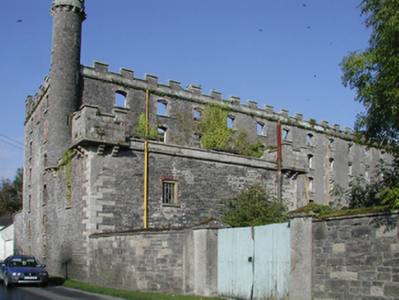Survey Data
Reg No
12402102
Rating
Regional
Categories of Special Interest
Architectural
Original Use
Mill (water)
Historical Use
Malt house
Date
1795 - 1805
Coordinates
268505, 155707
Date Recorded
12/10/2004
Date Updated
--/--/--
Description
Detached fourteen-bay (two-bay deep) six-storey mill, built 1800, on a T-shaped plan originally seven-bay (single-bay deep) four-storey on a rectangular plan with two-bay (five-bay deep) six-storey central return (north). In alternative use, 1911. Disused, 1973. Now in ruins. Roof now missing retaining cast-iron octagonal or ogee hoppers and downpipes. Part creeper- or ivy-covered coursed rubble limestone walls retaining sections of rendered surface finish (east) with cut- or hammered granite flush quoins to corners supporting battlemented parapets on lichen-spotted cut-limestone stringcourses having lichen-spotted cut-granite "saddleback" coping. Square-headed window openings in camber- or segmental-headed recesses with cut-granite sills, and red brick block-and-start surrounds framing remains of six-over-six timber sash windows without horns behind wrought iron bars. Square-headed window openings (north) with red brick block-and-start surrounds framing rendered infill. Interior in ruins. Set in unkempt grounds perpendicular to road with roughcast piers to perimeter having pyramidal capping supporting corrugated-iron double gates.
Appraisal
A mill erected by John Handy (1778-pre-1859) of Barraghcore House (see 12402103) representing an important component of the industrial heritage of County Kilkenny with the architectural value of the composition, one recalling the John Alexander (1763-1843)-built Strong Stream Mills (1790) in Milford in neighbouring County Carlow, confirmed by such attributes as the elongated plan form; the uniform or near-uniform proportions of the openings on each floor; and the battlemented parapets embellishing the roofline: meanwhile, a failing surface finish revealing pronounced masonry breaks clearly illustrates the continued development of the mill in the nineteenth century. A prolonged period of neglect notwithstanding, the elementary form and massing survive intact together with quantities of the original fabric, including crown or cylinder glazing panels in hornless sash frames, thus upholding the character or integrity of a mill making an impressive visual statement overlooking the River Barrow.

